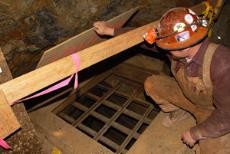When most students were in bed recovering from the chaos of midterms Saturday morning, Danny Marsh was at work 150-feet underground. Marsh, a mining engineering junior, was on the lowest level of the San Xavier Mining Laboratory outside of Sahuarita, about 25 miles south of campus.
“”I like doing it, it’s just fun,”” Marsh said of his work at the mine.
The mine at 6200 W. Ocotillo Rd. is owned by the UA and operated by students in the department of mining and geological engineering. It serves mainly as a learning laboratory for students, said Robert Tracy, mining engineering junior and mine manager.
“”It’s like any lab at the UA, it follows the same rules, but it’s totally different from what you’d normally see,”” Tracy said.
The lab is unique, not just at the UA, but worldwide. It is the only multi-level mine in the world operated by students, Marsh said.
Mining undergraduates come to the mine to practice hands-on mining techniques such as tunneling, laying rails, drilling and welding. Unlike most mines, the San Xavier mine does not produce profitable ore. Instead, the facility exists to give students the practical mining experience they can’t get in the classroom.
“”This is a big sandbox for us to play in,”” Tracy said.
The hole-filled boulders outside of Old Main came from an annual drilling competition held on campus. The rocks are known for their secret musical ability of producing pitched sounds when hit with a hand or shoe.
In the mine, these same types of holes might be filled with explosives or used to lodge rock bolts that hold the walls of the mine up “”like a toothpick in a sandwich,”” Marsh said.
The mine, which encompasses three subterranean levels spread across 35 acres, has been used for educational purposes since Anamax Mining Company donated it to the UA in 1975. Before that, it had been used to harvest “”base metal concentrates”” since its opening in 1880, according to a visitor information pamphlet.
Mining is like anything, said John “”Ros”” Hill, a professor of mining engineering and the lab’s director. “”You need experience in the business.””
Hill said students are “”learning mining from the ground up.””
Another feature that makes the San Xavier mine unique among UA labs is that it receives no funding from the university. Instead, Hill said, the mine is funded by income generated by leasing the mine to private companies for safety and drilling training.
One of the most frequent users of the mine is Laborers Union International, which pays up to $1,000 a day to train the so-called “”sand hogs”” of History Channel fame who drill subway tunnels under New York City, Hill said.
The mine has also recently received funding from Science Foundation Arizona, a non-profit group that funds scientific research in Arizona. That money is being used to expand the San Xavier facility, said Moe Momayez, a mining and geological engineering professor.
For students here, the mine is already an invaluable learning tool.
“”Every day is a challenge. That’s one thing about working out here is that you learn that,”” Tracy said. “”Whereas if you’re just in school looking at it on paper, you go out to the job site and the first day something messes up, then you freak out. But out here, that’s normal operating procedure.””









